It looks like you're using an Ad Blocker.
Please white-list or disable AboveTopSecret.com in your ad-blocking tool.
Thank you.
Some features of ATS will be disabled while you continue to use an ad-blocker.
share:
reply to post by Destinyone
reply to post by snypwsd
Here are some closeups of the glyph on the back. The section below the crescent to me looks like shoulders and torso with perhaps the head decapitated by the scrape mark. There appears to be a double chevron below the torso similar to the chevrons in your example.
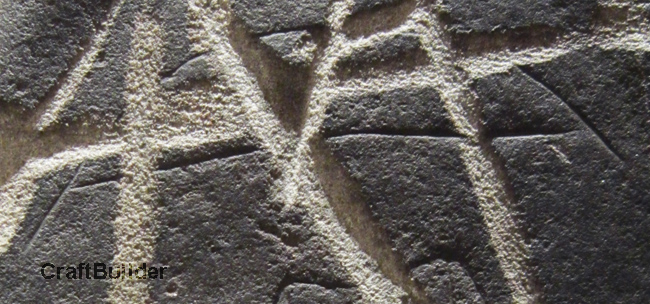
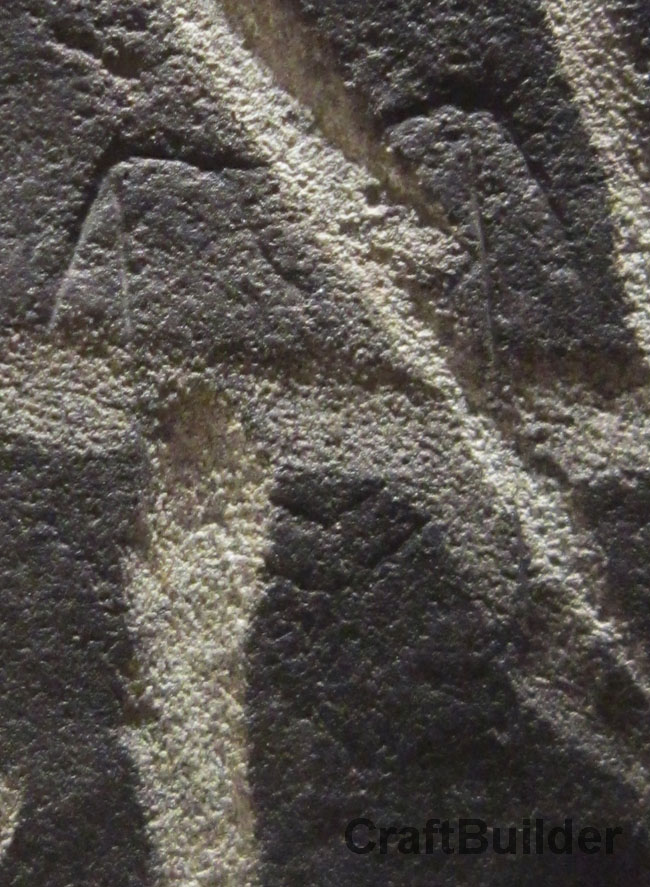
reply to post by snypwsd
Here are some closeups of the glyph on the back. The section below the crescent to me looks like shoulders and torso with perhaps the head decapitated by the scrape mark. There appears to be a double chevron below the torso similar to the chevrons in your example.


edit on 11-1-2014 by CraftBuilder because: I added the second reply code.
reply to post by CraftBuilder
Aren't the scars on the back meant to be from agricultural machinery? Like rotavators and the like?
That's what it says in the OP...
Aren't the scars on the back meant to be from agricultural machinery? Like rotavators and the like?
That's what it says in the OP...
reply to post by iRoyalty
Yes, but below the scars is a thin line glyph. Actually there are two glyphs still visible (upper and lower of disk) that may or may not be related. The upper glyph is an upside-down crescent and the lower glyph is a complex drawing with a couple of chevrons.
I will see about tracing them out on another image.
Yes, but below the scars is a thin line glyph. Actually there are two glyphs still visible (upper and lower of disk) that may or may not be related. The upper glyph is an upside-down crescent and the lower glyph is a complex drawing with a couple of chevrons.
I will see about tracing them out on another image.
This image traces what remains of the glyphs on the back of the disk.
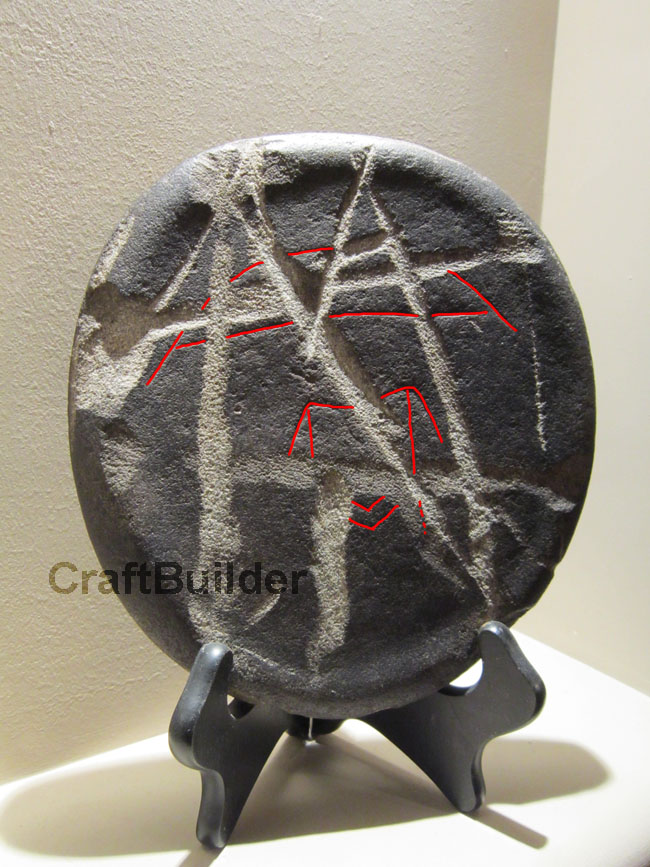
And without the trace.
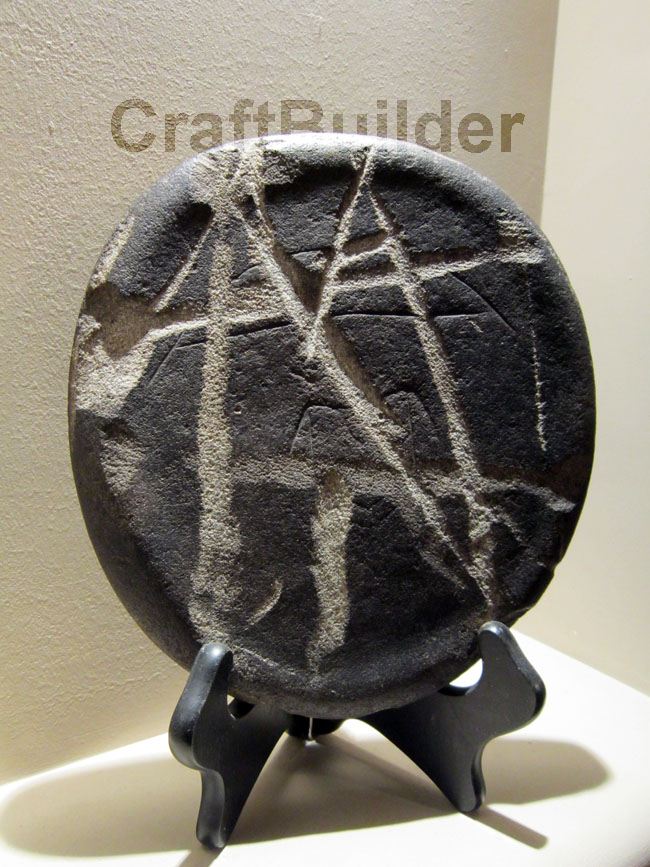

And without the trace.

edit on 11-1-2014 by CraftBuilder because: I fixed the image link.
reply to post by CraftBuilder
Ok I was able to find a acouple examples of stone figures that resemble that carving. They are not exactly the same but they are close (80-90% percent the same). I am currently using the wii at the moment to do this research, as soon as my roommate is done with the computer I will post my findings and scan in the rough sketch I made to use as a reference for finding these objects. should be up in a hour or two
By the way, Thanks for the close ups they helped a lot. Also whom ever posted the Negative of the pic, THANK YOU, It made a world of difference because you can judge the depths of the striations better. Man Im excited about this!
Ok I was able to find a acouple examples of stone figures that resemble that carving. They are not exactly the same but they are close (80-90% percent the same). I am currently using the wii at the moment to do this research, as soon as my roommate is done with the computer I will post my findings and scan in the rough sketch I made to use as a reference for finding these objects. should be up in a hour or two
By the way, Thanks for the close ups they helped a lot. Also whom ever posted the Negative of the pic, THANK YOU, It made a world of difference because you can judge the depths of the striations better. Man Im excited about this!
Interesting find.
Maybe the urleute used it for some kind of a ritual.
Maybe the urleute used it for some kind of a ritual.
Now that I look at the back with the glyph traced out I wonder if it could be like the carver's signature symbol. Maybe they were the local shelter
builder too (Ha!).
I wonder if the surfaces of the carvings on the front and the back could compared for erosion (or another technique) to determine if they are the same age.
I wonder if the surfaces of the carvings on the front and the back could compared for erosion (or another technique) to determine if they are the same age.
edit on 11-1-2014 by CraftBuilder because: it was missing a certain je ne sais quoi.
reply to post by CraftBuilder
Now that you say that the top side sort of resembles a teepee. Im not saying thats what it is, but to some degree it does resemble that.
Now that you say that the top side sort of resembles a teepee. Im not saying thats what it is, but to some degree it does resemble that.
ExoPatriotico
reply to post by Xcathdra
The SCARS are covering the glyph - they are not indicators of any kind of an alignment - they are plow marks. Look at the drawing under the scars.
edit on 11-1-2014 by ExoPatriotico because: (no reason given)
Uhm no... what im saying is when you compare the images on the glyph, are you comparing it as it, or are you rotating the image and comparing.
reply to post by CraftBuilder
To identify what Tribes would be a potential source, a general region would be helpful...
To identify what Tribes would be a potential source, a general region would be helpful...
reply to post by BuzzDengue
I had that thought as well, especially with the lip on the back side. I certainly don't have the expertise to make an informed hypothesis though. I'm starting to get the impression that it might have had a significant ceremonial purpose because of the amount of skilled work that went into it and if the lip on the back is maybe for handling grip.
I had that thought as well, especially with the lip on the back side. I certainly don't have the expertise to make an informed hypothesis though. I'm starting to get the impression that it might have had a significant ceremonial purpose because of the amount of skilled work that went into it and if the lip on the back is maybe for handling grip.
reply to post by BuzzDengue
reply to post by dainoyfb
For now I'm putting my money on prehistoric frisbee.
reply to post by dainoyfb
For now I'm putting my money on prehistoric frisbee.
Xcathdra
what im saying is when you compare the images on the glyph, are you comparing it as it, or are you rotating the image and comparing.
Sorry Xcathdra, I'm not sure what you mean. When comparing it with what?
Would it be a North American Indian carving?
It might be sandstone
It's an interesting and exciting find.
I hope you can get some answers
It might be sandstone
It's an interesting and exciting find.
I hope you can get some answers
edit on 11-1-2014 by violet because: (no reason given)
reply to post by CraftBuilder
He's asking about perspective. When you look at the petroglyph on the obverse are you always looking at it from the same angle/direction ie a view consistent with the photos posted in the OP or have you thought to rotate the object to see if the image gives a different appearance when viewed from the new perspective. The side with the sun will be fairly consistent no matter ow you rotate it where the obverse will appear differently. It may give the appearance of a different animal for example if you rotated the stone 180 degrees or 90 deg.
He's asking about perspective. When you look at the petroglyph on the obverse are you always looking at it from the same angle/direction ie a view consistent with the photos posted in the OP or have you thought to rotate the object to see if the image gives a different appearance when viewed from the new perspective. The side with the sun will be fairly consistent no matter ow you rotate it where the obverse will appear differently. It may give the appearance of a different animal for example if you rotated the stone 180 degrees or 90 deg.
As soon as I saw the first image, for some reason the recollection of a widows-mite roman coin came to mind. These are 2000 years old Judean coins
from the time of Jesus.... They are very tiny.
I wonder if there is any connection to the symbolism on this large stone object.
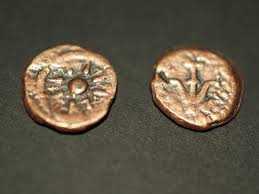
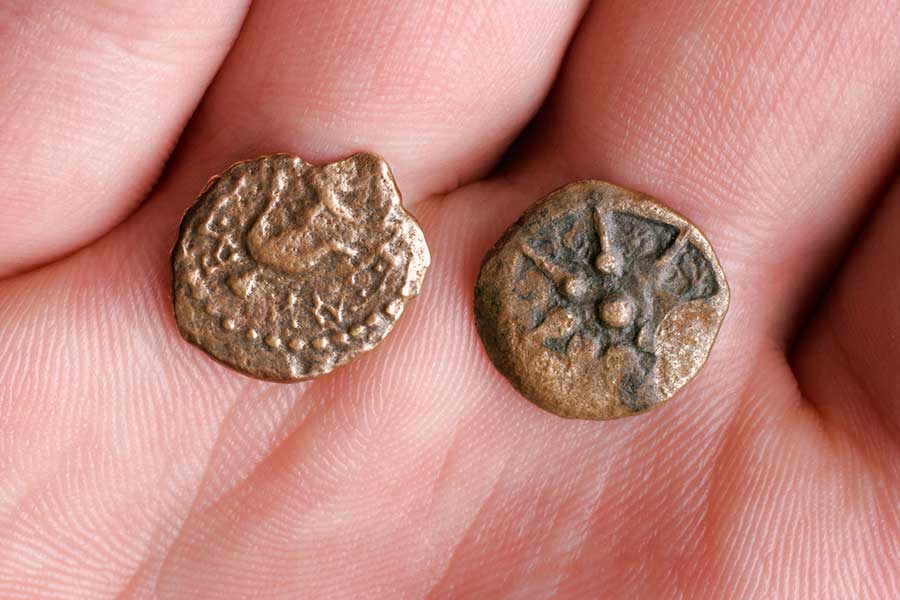
IMHO, but that stone object seems quite old and I wonder what it was modeled after.
I wonder if there is any connection to the symbolism on this large stone object.


IMHO, but that stone object seems quite old and I wonder what it was modeled after.
reply to post by violet
I don't know if carving methods this advanced go back far enough in First Peoples (Aboriginal peoples/ Fist Nations, Metis, Indigenous Peoples) culture as we know them historically to account for this carving but I'm no expert.
The stone is very similar to granite. It is very hard, heavy and difficult to work. A relief carving this old in this type of stone makes it particularity impressive. In Alberta there is no flint or obsidian. Until flint imports began, tools such as arrow heads had to be knapped from field stone. They look crude compared to tools knapped from flint but the skill level to do so was much higher.
I don't know if carving methods this advanced go back far enough in First Peoples (Aboriginal peoples/ Fist Nations, Metis, Indigenous Peoples) culture as we know them historically to account for this carving but I'm no expert.
The stone is very similar to granite. It is very hard, heavy and difficult to work. A relief carving this old in this type of stone makes it particularity impressive. In Alberta there is no flint or obsidian. Until flint imports began, tools such as arrow heads had to be knapped from field stone. They look crude compared to tools knapped from flint but the skill level to do so was much higher.
new topics
-
A Warning to America: 25 Ways the US is Being Destroyed
New World Order: 19 minutes ago -
America's Greatest Ally
General Chit Chat: 1 hours ago -
President BIDEN's FBI Raided Donald Trump's Florida Home for OBAMA-NORTH KOREA Documents.
Political Conspiracies: 6 hours ago -
Maestro Benedetto
Literature: 7 hours ago -
Is AI Better Than the Hollywood Elite?
Movies: 7 hours ago -
Las Vegas UFO Spotting Teen Traumatized by Demon Creature in Backyard
Aliens and UFOs: 11 hours ago
top topics
-
President BIDEN's FBI Raided Donald Trump's Florida Home for OBAMA-NORTH KOREA Documents.
Political Conspiracies: 6 hours ago, 26 flags -
Krystalnacht on today's most elite Universities?
Social Issues and Civil Unrest: 17 hours ago, 9 flags -
Gaza Terrorists Attack US Humanitarian Pier During Construction
Middle East Issues: 12 hours ago, 8 flags -
Supreme Court Oral Arguments 4.25.2024 - Are PRESIDENTS IMMUNE From Later Being Prosecuted.
Above Politics: 17 hours ago, 8 flags -
Weinstein's conviction overturned
Mainstream News: 15 hours ago, 8 flags -
Massachusetts Drag Queen Leads Young Kids in Free Palestine Chant
Social Issues and Civil Unrest: 14 hours ago, 7 flags -
Las Vegas UFO Spotting Teen Traumatized by Demon Creature in Backyard
Aliens and UFOs: 11 hours ago, 6 flags -
Meadows, Giuliani Among 11 Indicted in Arizona in Latest 2020 Election Subversion Case
Mainstream News: 14 hours ago, 5 flags -
2024 Pigeon Forge Rod Run - On the Strip (Video made for you)
Automotive Discussion: 12 hours ago, 4 flags -
Is AI Better Than the Hollywood Elite?
Movies: 7 hours ago, 3 flags
active topics
-
Massachusetts Drag Queen Leads Young Kids in Free Palestine Chant
Social Issues and Civil Unrest • 15 • : tarantulabite1 -
A Warning to America: 25 Ways the US is Being Destroyed
New World Order • 0 • : charlest2 -
America's Greatest Ally
General Chit Chat • 1 • : BingoMcGoof -
How ageing is" immune deficiency"
Medical Issues & Conspiracies • 35 • : annonentity -
HORRIBLE !! Russian Soldier Drinking Own Urine To Survive In Battle
World War Three • 49 • : Freeborn -
Gaza Terrorists Attack US Humanitarian Pier During Construction
Middle East Issues • 30 • : Asher47 -
Electrical tricks for saving money
Education and Media • 8 • : anned1 -
Is AI Better Than the Hollywood Elite?
Movies • 16 • : 5thHead -
Hate makes for strange bedfellows
US Political Madness • 48 • : Terpene -
President BIDEN's FBI Raided Donald Trump's Florida Home for OBAMA-NORTH KOREA Documents.
Political Conspiracies • 17 • : BingoMcGoof
